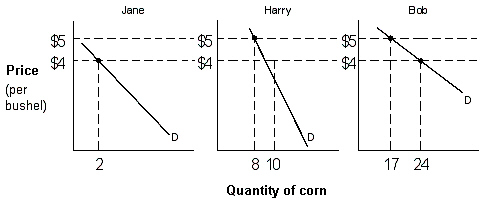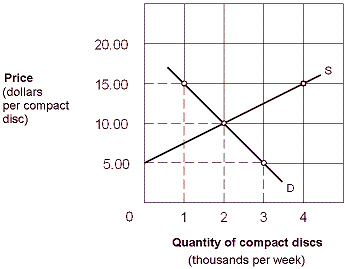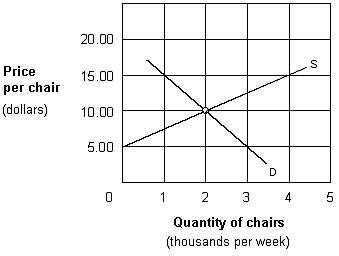A) law of supply.
B) law of quantity supply.
C) law of demand.
D) law of quantity demanded.
E) point that some facts are unobservable.
Correct Answer

verified
Correct Answer
verified
True/False
If movies are an inferior good, movie attendance will rise when consumer incomes fall.
Correct Answer

verified
Correct Answer
verified
Multiple Choice
Exhibit 3-1 Market Demand  In Exhibit 3-2, which of the following could not have caused the shift in the demand curve from D1 to D2?
In Exhibit 3-2, which of the following could not have caused the shift in the demand curve from D1 to D2?
A) Decrease in the number of consumers.
B) Increase in expected future prices.
C) Increase in the price of a substitute.
D) Decrease in the price of a complement.
E) Increase in income.
Correct Answer

verified
Correct Answer
verified
Multiple Choice
When economists say the quantity supplied of a product has decreased, they mean the:
A) supply curve has shifted to the left.
B) supply curve has shifted to the right.
C) price of the product has risen, and consequently, suppliers are producing more of it.
D) price of the product has fallen, and consequently, suppliers are producing less of it.
Correct Answer

verified
Correct Answer
verified
Multiple Choice
Exhibit 3-14 Supply and demand curves  In Exhibit 3-14, assume that the price of compact discs is $5 each. This price is:
In Exhibit 3-14, assume that the price of compact discs is $5 each. This price is:
A) an equilibrium price.
B) not an equilibrium price because there is an excess quantity supplied at a price of $5.
C) not an equilibrium price because there is an excess quantity demanded at a price of $5.
D) not an equilibrium price because the quantity supplied of compact discs is greater than the quantity demanded.
Correct Answer

verified
Correct Answer
verified
Multiple Choice
The " ceteris paribus " clause in the law of demand does not allow which of the following factors to change?
A) Consumer tastes and preferences.
B) The prices of other goods.
C) Expectations.
D) All of these.
Correct Answer

verified
Correct Answer
verified
Multiple Choice
Assume that the equilibrium price for a good is $5. If the market price is $10, a:
A) shortage causes the price to decline toward $5.
B) surplus causes the price to rise above $10.
C) shortage causes the price to rise above $10.
D) surplus causes the price to decline toward $5.
Correct Answer

verified
Correct Answer
verified
Multiple Choice
Assuming compact discs and cassettes are substitute goods, a decrease in the price of cassettes will cause the demand curve for compact discs to:
A) shift to the left as consumers switch from buying discs to cassettes.
B) shift to the right as consumers switch from buying discs to cassettes.
C) shift to the left as producers increase cassette production and reduce disc production.
D) remain unchanged since discs and cassettes are sold in separate markets.
Correct Answer

verified
Correct Answer
verified
Multiple Choice
If there is an increase in income, which of the following is true ?
A) The demand for complementary goods decreases.
B) The demand for substitute goods decreases.
C) The demand for normal goods decreases.
D) The demand for normal goods increases.
E) The supply for all goods decreases.
Correct Answer

verified
Correct Answer
verified
Multiple Choice
Tickets to the Indiana-Purdue basketball game are usually sold out in advance of game day. This suggests:
A) the price of the tickets must be very high or else people would not consider them valuable.
B) the price is set below the equilibrium level.
C) the Indiana basketball stadium is relatively small.
D) everyone who attends the game will enjoy it.
Correct Answer

verified
Correct Answer
verified
Multiple Choice
The development of new technology typically:
A) shifts the supply curve to the right.
B) reduces profits.
C) results in a downward movement along a supply curve.
D) increases costs of production.
E) shifts the demand curve to the right.
Correct Answer

verified
Correct Answer
verified
Multiple Choice
To finance medical care, the federal government raises the tax per pack paid by sellers of cigarettes. Other things being equal, the price of cigarettes rises because of a(n) :
A) upward movement along the supply curve for cigarettes.
B) rightward shift of the supply curve for cigarettes.
C) upward movement along the demand curve for cigarettes.
D) leftward shift of the supply curve for cigarettes.
Correct Answer

verified
Correct Answer
verified
Multiple Choice
If the price of coffee decreases, the demand curve for tea (a substitute good) will:
A) remain unchanged.
B) shift to the right.
C) shift to the left.
D) do none of these
Correct Answer

verified
Correct Answer
verified
Multiple Choice
If butter is a substitute for margarine, then an increase in the price of butter would be most likely to cause:
A) a rightward shift of demand for margarine.
B) a leftward shift of demand for margarine.
C) the quantity demanded for margarine to increase.
D) the quantity demanded for margarine to decline.
E) a decline in the price of margarine.
Correct Answer

verified
Correct Answer
verified
Multiple Choice
Travel by bus and pawn-shop services would be expected to be examples of:
A) normal goods.
B) inferior goods.
C) substitute goods.
D) complementary goods.
Correct Answer

verified
Correct Answer
verified
Multiple Choice
Assuming that wheat and corn can both be grown on the same type of land, a decrease in the price of corn, other things being equal, will cause a(n) :
A) downward movement along the supply curve for wheat.
B) upward movement along the supply curve for wheat.
C) rightward shift in the supply curve for wheat.
D) leftward shift in the supply curve for wheat.
Correct Answer

verified
Correct Answer
verified
Multiple Choice
In general, supply curves slope upward because:
A) increases in the price of a good result in lower opportunity costs.
B) rising prices provide producers with a greater profit incentive.
C) consumers buy a greater quantity.
D) technology improves the ability of firms to produce more at each possible price.
Correct Answer

verified
Correct Answer
verified
Multiple Choice
A rightward shift in the demand curve is called a(an) :
A) decrease in output.
B) decrease in demand.
C) increase in demand.
D) increase in income.
Correct Answer

verified
Correct Answer
verified
Multiple Choice
The law of demand is graphically demonstrated by a(n) :
A) perfectly vertical demand curve.
B) perfectly horizontal demand curve.
C) downward-sloping demand curve.
D) upward-sloping demand curve.
E) curved demand line.
Correct Answer

verified
Correct Answer
verified
Multiple Choice
Exhibit 3-16 Supply and demand curves for chairs  In Exhibit 3-16, if the market price of chairs is initially $15, a movement toward equilibrium would require:
In Exhibit 3-16, if the market price of chairs is initially $15, a movement toward equilibrium would require:
A) no change, because an equilibrium already exists.
B) the price to fall below $15 and both the quantity supplied and the quantity demanded to fall.
C) the price to remain the same, but the supply curve to shift to the left.
D) the price to fall below $15, the quantity supplied to fall, and the quantity demanded to rise.
Correct Answer

verified
Correct Answer
verified
Showing 161 - 180 of 348
Related Exams